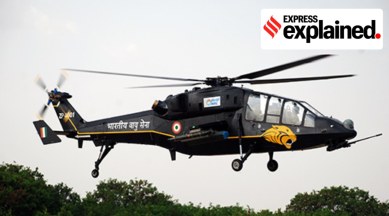Explained: Features of India-made light combat helicopters
The Cabinet Committee of Security has approved the procurement of 15 indigenously developed Light Combat Helicopters (LCH). When was the LCH project envisaged? What are the major features of LCH, and what are the roles in which it can be deployed?

The Cabinet Committee on Security (CCS) on Wednesday (March 30) approved the procurement of 15 indigenously developed Light Combat Helicopters (LCH) at a cost of Rs 3,887 cr along with infrastructure sanctions worth Rs 377 cr. The decision was taken at a meeting chaired by the Prime Minister Narendra Modi.
When was the LCH project envisaged?
It was in 2006 that the Hindustan Aeronautics Limited (HAL) announced its intention to develop a LCH which could operate in the harsh desert conditions as well as the high altitude areas of Ladakh including the Siachen Glacier.
How did the development of the LCH progress?
The first ground run of the first prototype of the LCH took place in February 2010 and a month later the first flight test of the helicopter also took place. Modifications were made to this prototype and the subsequent version was made public at the Aero India 2011 in February, and in June that year the flight test of the second prototype took place. A third prototype was further tested in November 2014 with integrated weapon platforms and sensors. This version was a considerably improved one with lighter weight and advanced configurations. In the coming year further hot weather and cold weather tests were done on the helicopter in Rajasthan and Ladakh and a fourth prototype was tested in November 2015.
It was in January 2019 that HAL gave the go ahead for the operational deployment of the helicopter after all systems had been fully integrated and checked for performance. The Defence Minister inaugurated the LCH production hangar at HAL Bengaluru in February 2020. The production line is reportedly geared up to deliver upto 30 helicopters a year.
What are the major features of LCH?
According to HAL, the LCH has “the maximum possible commonality with Advanced Light Helicopter (ALH)”. The attack helicopter has a pilot and co-pilot sitting in tandem position (one behind the other). The helicopter has several stealth features and has armour protection, night attack capability and crash worthy landing gear to give it better survivability.
It is powered by two Shakti engines and has a maximum take off weight of 5,800 kg. With a maximum speed of 268 km per hour it has a range of 550 km and an operational ceiling of 6.5 kms. Armed with air-to-air and air-to-ground missiles, LCH also has a 20 mm gun and 70 mm rockets. With a full glass cockpit, the LCH has an Electronic Warfare suite and helmet mounted display for the flying crew.
What are the roles in which LCH can be deployed?
The LCH is well suited for anti-tank role wherein it can fly low and fast to attack enemy armour columns and destroy them. As per HAL, it is also suitable for scout role wherein it can fly ahead of advancing columns of the Army and detect enemy presence. It is also suitable for air defence roles and destruction of enemy air defence assets. It can also be used in urban warfare missions and combat search snd rescue operations.
Newsletter | Click to get the day’s best explainers in your inbox